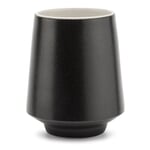Bogler mug b/w

Bogler mug b/w
- Tradition of a region: pottery from the Eifel
- Shapes with history: Bogler mug
- Precision and eye: made by slip casting
General Information
Ceramics from Maria Laach
The production of ceramic objects has a long tradition in the Benediktinerabtei Maria Laach in the Eifel. In any case, the monastery is located in a region where this craft has been influential for hundreds of years. In Maria Laach in particular, it experienced a new heyday in the first half of the 20th century thanks to the Bauhaus-trained monk Theodor Bogler. Brother Stephan, who is now in charge of the monastery's ceramics workshop, and his seven employees continue the traditions of the place and the region in many different ways. Among other things, they have perfected a casting process that Bogler himself established at the time.
From liquid clay to drinking vessel
The talk is of the so-called Schlickertonguss, in which liquid clay is poured into plaster molds. What sounds simple and easy, actually takes several days of work and requires, in addition to craftsmanship, a trained eye, patience and, in the best case, good weather. At the beginning, the clay is weighed, because a liter of liquid clay weighs a full three kilograms - too much weight for a cup. In general, measurements are taken frequently in the monastic ceramics workshop, since on slip casting days the air pressure also has to be checked regularly. In summer, when the ambient air is dry and the sun shines continuously, the plaster molds can usually be used three times a week, that is, refilled. In autumn and winter, when it rains or snows more often and the ambient air is more humid, on the other hand, can be a maximum of two passes a week.
The cast clay is first air-dried in the mold for about a day, then unmolded and again air-dried for some time. Whether the material reaches the appropriate thickness during this process is not visible to the eye alone, so a needle is used to prick the clay - comparable to the "wood sample" used in cake baking. An acoustic test also provides information about whether the drying time has been sufficient overall: if you flick your finger against the hollow clay mold, the more thoroughly the mold has dried, the clearer and higher the sound. The cups take on their final shape only when the blanks are worked on the potter's wheel. Then they are fired in the kiln at temperatures of about 1,100 ° C.
Through and through Eifel. Our Bogler mugs
After this first firing, the drinking vessels are ready for glazing. Carefully, each mug is dipped into the liquid by hand. Precision and a sense of proportion are also required here, especially for the two-tone glazed models.
All glazes used in Maria Laach are home-made. For example, to produce the black glaze, glass powder is mixed with finely ground basalt, which comes from rock deposits in the region. A reverence to the building history of the monastery: Have you ever been there? Then you know that the church building rests on load-bearing elements made of basalt. On closer inspection, the dark glaze still reveals the crystalline structure of this volcanic rock. The creamy white glaze with its elegant, almost silky sheen is made from a mixture of glass powder and dolomite powder (rock flour). Rock flour has the advantage of being very acid-resistant and can also withstand higher firing temperatures. Because to consolidate the glazes, our Bogler cups from the black-and-white series for good measure once again at 1,250 ° C in the kiln - for three days, without interruption.
By the way, the clay is also obtained in the neighborhood of the monastery. The clay pit is located only ten kilometers away. For processing, the raw material is brought to the Westerwald, where specialists take care of him, clean him, dry and grind. Only when it is to be worked with, the ground clay is again enriched with water and pressed in a vacuum press.
Hint:
This product is an example of genuine handicraft; therefore, minor deviations in size and colour may occur.
Product Information
Article Number 209466
- Tradition of a region: pottery from the Eifel
- Shapes with history: Bogler mug
- Precision and eye: made by slip casting
ceramic glazed. Volume 400 ml. Height 11 cm. Drinking rim Ø 7 cm (bottom Ø 9 cm). Bottom Ø 5 cm. Weight 300 g.
Have a question?
If you have a question concerning this product you are welcome to contact us. For this your E-Mail program will open.
Customer Service
Ob Beratung, Ersatzteile oder Sonderwünsche - all Ihre Fragen und Anliegen behandelt unser Customer Service persönlich und fundiert.
Sie erreichen uns von Montag bis Freitag unter der Nummer +49 2309 939095 oder jederzeit unter info@manufactum.de
Gutes aus Klöstern
Wir bringen lebendige Klosterkultur aus ganz Europa direkt zu Ihnen nach Hause – in Form schmackhafter, pflegender und handwerklich ausgereifter Produkte, die sich im klösterlichen Alltag für Leib und Seele längst bewährt haben
Gutes aus Klöstern


